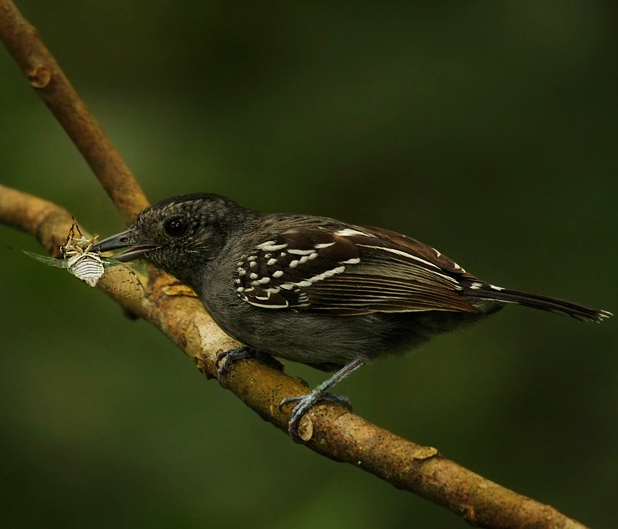 |
| Photo by Tobias Gerlach (Deep Green Photo) |
Common name:
western slaty-antshrike (en); choca-de-nuca-negra (pt); batara à nuque noire (fr); batará pizarroso occidental (es); westlicher tropfenameisenwürger (de)
Taxonomy:
Order Passeriformes
Family Thamnophilidae
Range:
This species is found from Guatemala to north-western Venezuela, western Colombia and western Ecuador.
Size:
These birds are 14-15 cm long and weigh 22-24 g.
Habitat:
The western slaty-antshrike is found in primary and secondary tropical moist and evergreen forests as well as forest edges. They occur from sea level up to an altitude of 1.500 m.
Diet:
They forage on the understory, often joining antwren flocks, and sometimes follow army ant swarms when these enter their territory. They mainly feed on arthropods, such as scorpions, spiders, millipedes, roaches, stick insects, mantids, crickets, katydids, grasshoppers, cicadas, bugs and moths. They are also known to prey on Anolis lizards.
Breeding:
These birds can breed all year round, but especially in December-September. They are socially monogamous and the nest is built by both sexes, consisting of a thin cup made of plant fibres, rhizomorphs, rootlets, spider webs and moss. It is tied to two or three small twigs of a horizontal fork, up to 7 m above the ground. There the female lays 1-2 white eggs with reddish-brown spots, which are incubated by both sexes for about 16 days. The chicks fledge 10 days after hatching. Each pair can raise 1-2 broods per year.
Conservation:
IUCN status – LC (Least Concern)
The western slaty-antshrike has a large breeding range and is described as fairly common to common throughout much of this range. This species is able to thrive in some edge and secondary habitats, thus the population is suspected to be at least stable.







